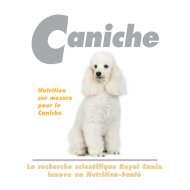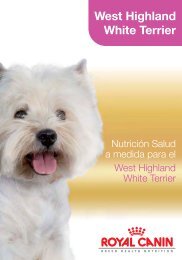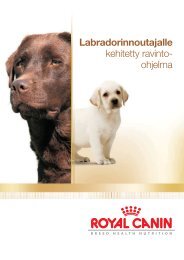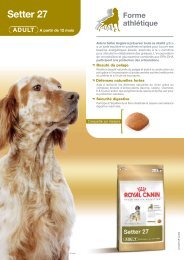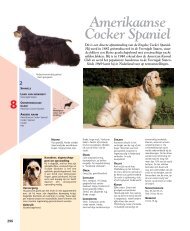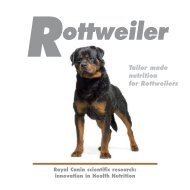Create successful ePaper yourself
Turn your PDF publications into a flip-book with our unique Google optimized e-Paper software.
English Cocker Spaniel - © J.-M. Labat<br />
During growth a Cocker puppy multiplies its<br />
birth weight by a factor 40 to 50.<br />
Preventing stoutness starts<br />
as early as possible<br />
The Cocker is a precocious dog, reaching its adult size between eight and ten months, although it<br />
does not fill out to adult weight until around twelve months.<br />
The puppy’s education starts with dietary behaviour. The best thing you can do is restrict your puppy’s<br />
access to food to around 10-15 minutes each time. It should get three meals a day, at regular<br />
intervals up to age six months or so, then two a day through the end of the growth phase.<br />
The puppy should not get into the habit of grazing from its bowl the whole day long.<br />
Parameters Ideal weight<br />
Ribs, vertebrae<br />
and pelvic bone<br />
It’s important to weigh your puppy at least once a week, tracing how the weight<br />
curve develops over time. If the dog veers off the curve it means that it is<br />
accelerating the storage of fats in adipocytes*, which do not disappear<br />
when the dog reaches adult age. So, by overfeeding the<br />
puppy you actually increase the risk that the dog will put on weight<br />
more easily in its adult years.<br />
not visible but<br />
very perceptible<br />
Criteria for assessing body condition<br />
10<br />
Overweight (10-20%<br />
above optimal weight)<br />
perceptible<br />
with difficulty<br />
Obesity (40% + above<br />
optimal weight)<br />
Abdominal girdle (waist) visible absent abdominal distension<br />
Adipose covering<br />
thin layer of perceptible fat<br />
tissue on the thoracic cage<br />
noticeable fat deposit<br />
on the vertebral column<br />
and the base of the tail<br />
massive fat deposit on the thorax,<br />
the vertebral column and the base<br />
of the tail



